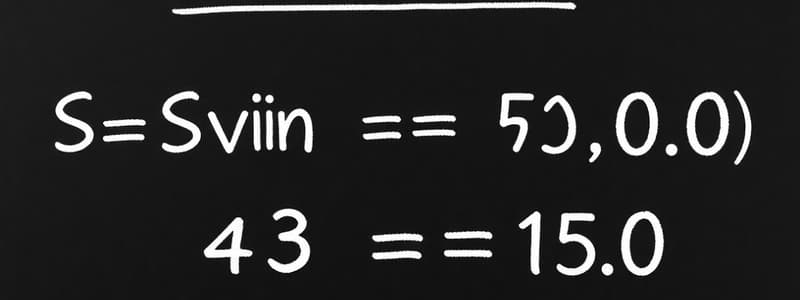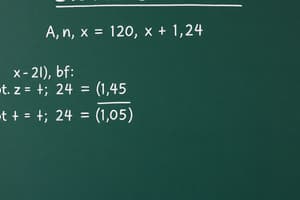Podcast
Questions and Answers
What is a sample in research?
What is a sample in research?
- A subset representing the entire population (correct)
- The entire group about which conclusions are drawn
- A constant value used for calculations
- A numeric characteristic of a population
When is universal sampling typically used?
When is universal sampling typically used?
- When resources are scarce
- When the population is less than 100 (correct)
- When the population is very large
- When high precision is not important
What does the formula sampling interval = N/n calculate?
What does the formula sampling interval = N/n calculate?
- Systematic sampling interval (correct)
- Probability distribution
- Margin of error
- Confidence level
What is a parameter in the context of population studies?
What is a parameter in the context of population studies?
What is the best way to determine an acceptable sample size?
What is the best way to determine an acceptable sample size?
Flashcards
Population
Population
The entire group you want to draw conclusions about.
Parameter
Parameter
A numeric characteristic of a population.
Sample
Sample
A subset that represents the entire population.
Statistic
Statistic
Signup and view all the flashcards
Universal Sampling
Universal Sampling
Signup and view all the flashcards
Study Notes
Population and Sample
- Population: The entire group a researcher wants to draw conclusions about.
- Sample: A subset of the population that represents the entire group. Data is collected from the sample.
Parameters and Statistics
- Parameter: A numerical characteristic of a population.
- Statistic: A numerical characteristic of a sample.
Sample Size Determination
- Larger samples generally lead to more reliable study results.
- Determining the acceptable sample size is essential for research.
- If the total population is 100 or less, the total population can be the sample size.
Slovin's Formula
- Formula used to calculate sample size:
- n = N / (1 + Ne²), where:
- n = sample size
- N = population size
- e = margin of error
- n = N / (1 + Ne²), where:
Example Using Slovin's Formula
- If the population (N) is 168 and the margin of error (e) is 0.05, the sample size (n) is 119.
Available Online Calculators
- Online sample size calculators are available.
Sampling Techniques
-
Probability Sampling:
- Uses randomization to ensure all population members have a chance of selection.
- Also called scientific sampling.
-
Non-Probability Sampling:
- Doesn’t rely on randomization techniques.
- Used when randomization isn't possible in order to obtain a representative sample, specifically in areas not possible to randomize.
Variations of Probability Sampling
- Simple Random Sampling: Every member has an equal chance.
- Stratified Random Sampling: Divides the population into subgroups, and members are selected randomly from each group.
- Systematic Random Sampling: Uses a specific system for selection, like every 3rd person on a list.
- Cluster Random Sampling: Divides the population into clusters, and every member from a selected cluster is considered a sample.
Variations of Non-Probability Sampling
- Convenience Sampling: Members are selected based on availability.
- Purposive Sampling: Members of a specific group are selected purposefully.
- Proportional and Non-proportional Quota Sampling: Members are sampled until exact proportions of certain data types are obtained, or until sufficient data in certain categories is collected.
- Diversity Sampling: Intentionally selecting members across different types of responses.
- Snowball Sampling: Sampled members help identify other members to be sampled until enough samples are collected.
Studying That Suits You
Use AI to generate personalized quizzes and flashcards to suit your learning preferences.




